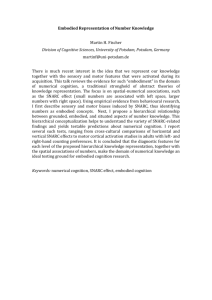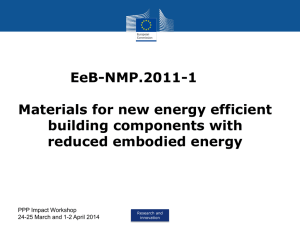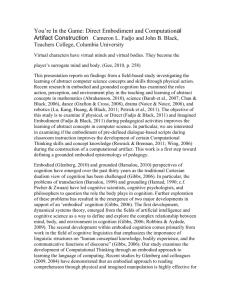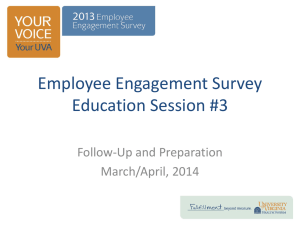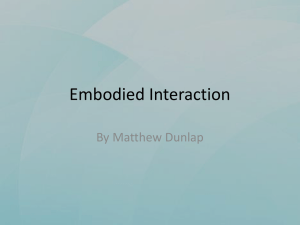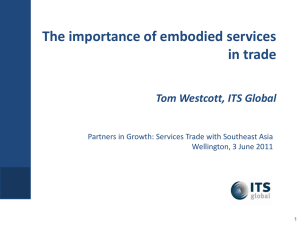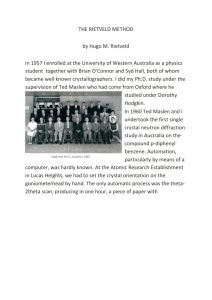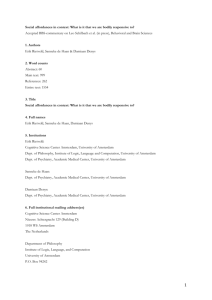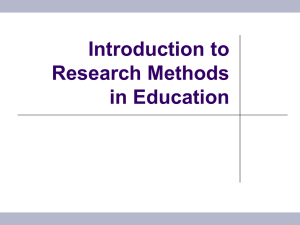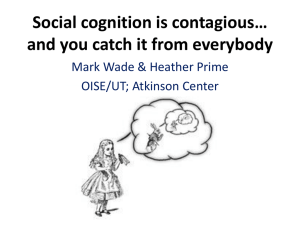Faculty of Humanities Proposal for a research group in the Faculty of
advertisement
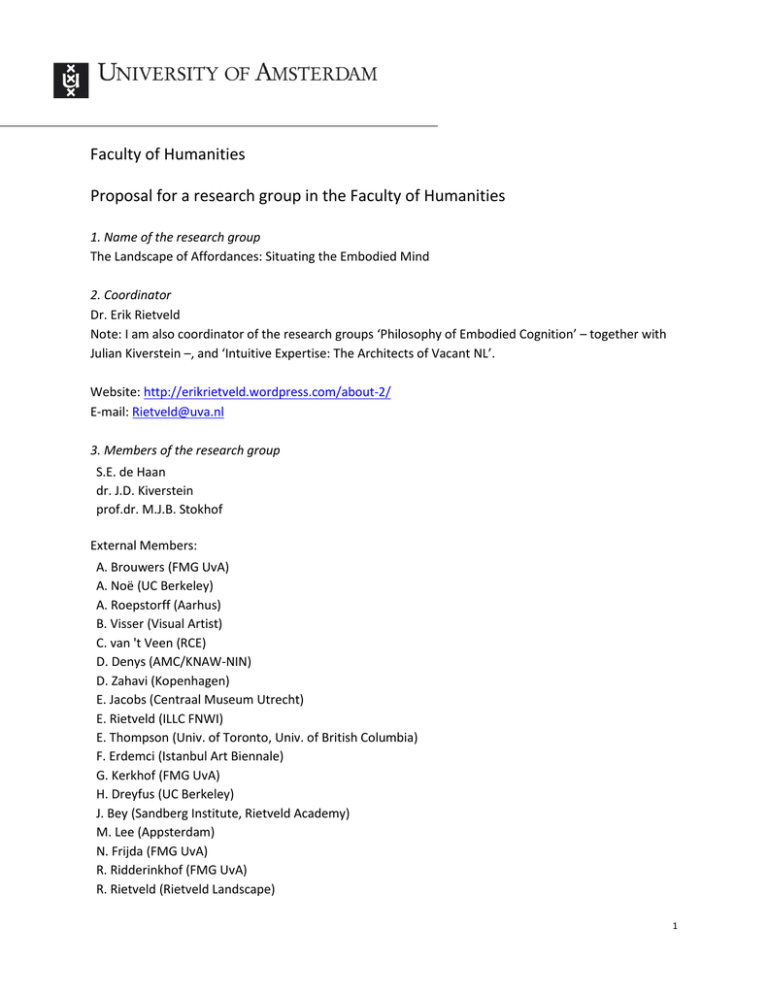
Faculty of Humanities Proposal for a research group in the Faculty of Humanities 1. Name of the research group The Landscape of Affordances: Situating the Embodied Mind 2. Coordinator Dr. Erik Rietveld Note: I am also coordinator of the research groups ‘Philosophy of Embodied Cognition’ – together with Julian Kiverstein –, and ‘Intuitive Expertise: The Architects of Vacant NL’. Website: http://erikrietveld.wordpress.com/about-2/ E-mail: Rietveld@uva.nl 3. Members of the research group S.E. de Haan dr. J.D. Kiverstein prof.dr. M.J.B. Stokhof External Members: A. Brouwers (FMG UvA) A. Noë (UC Berkeley) A. Roepstorff (Aarhus) B. Visser (Visual Artist) C. van 't Veen (RCE) D. Denys (AMC/KNAW-NIN) D. Zahavi (Kopenhagen) E. Jacobs (Centraal Museum Utrecht) E. Rietveld (ILLC FNWI) E. Thompson (Univ. of Toronto, Univ. of British Columbia) F. Erdemci (Istanbul Art Biennale) G. Kerkhof (FMG UvA) H. Dreyfus (UC Berkeley) J. Bey (Sandberg Institute, Rietveld Academy) M. Lee (Appsterdam) N. Frijda (FMG UvA) R. Ridderinkhof (FMG UvA) R. Rietveld (Rietveld Landscape) 1 Faculty of Humanities R. van der Heide (Philips) R. van Gent (TU Delft) S. Kelly (Harvard) V. Kompier (Urban Planning) K. Friston (UCL) Knowledge Application: Provincie Utrecht; Netherlands Architecture Institute/The New Institute; Netherlands Architecture Fund (SFA)/Creative Industries Fund; AMC Research Council. 4. Description of the research programme of the research group (max. 400 words) The Landscape of Affordances: Situating the Embodied Mind In many situations, experts at work act successfully, yet without deliberation. Architects, for example, perceive immediately the opportunities offered by the site of a new project, and intuitively improve the size of the door in one of their designs. One could label these manifestations of expert intuition as ‘higher-level’ cognition, but still these experts are just acting unreflectively. Traditionally in philosophy, so-called ‘higher’ cognitive capacities are associated more with explicit deliberation and linguistic forms of rationality than with unreflective action, but this has left unexplained the characteristic phenomenon of intuitive expertise (e.g. intuitively improving a design). The two central ideas behind this NWO VIDI-/ERC Starting Grant-proposal are (a) that many of these context-sensitive episodes of ‘higher’ cognition can be understood along the same lines as everyday skillful unreflective activities, such as grasping a coffee cup or riding a bike; and (b) that our surroundings contribute to skillful action and cognition in a far more fundamental way than is generally acknowledged. The overarching aim of this project is to use these ideas to develop a novel conceptual framework for embodied cognitive science (Thompson, 2007; Chemero, 2009). The cognition we find in expert intuition is very context-sensitive because it consists of responsiveness to multiple possibilities for action provided by our surroundings, or ‘affordances’. I argue that the notion of affordances is rich in application, so it makes sense to say both that a cup affords grasping and that a friend’s sad face affords comforting. Embodied cognition amounts here to skillful responsiveness to the many affordances available in one’s surroundings. 2 Faculty of Humanities This framework is innovative in showing how the increasingly influential field of embodied cognitive science has a much wider scope than previously thought. Findings thought to be exclusively valid for everyday unreflective action (or for sensorimotor behavior) can now be applied to skilled ‘higher’ cognition (project 1). Moreover, it brings the context and the social back into cognitive science. We will also show concrete, real-world applications in the domains of architecture (project 2) and psychiatry (project 3), respectively. Another interdisciplinary collaboration will advance its convergence with Karl Friston’s influential work on the anticipating brain (project 4). 5. Envisaged results (max. 100 words) This research plan for a large 5-year project is currently under evaluation in the final rounds of both the NWO VIDI and the ERC Starting Grant. The proposal includes funding for one PhD-student and three Post-docs. Scientific Results: We will publish articles on the results of the four projects in international top philosophy journals, architecture journals, and interdisciplinary journals in cognitive science. Knowledge utilization: We use our innovative philosophical framework to contribute to better treatments for psychiatric patients with Deep Brain Stimulation, not just at the AMC but worldwide. Additionally, we will exhibit results at the Venice Architecture Biennale, a high-impact event in the world of architecture. 6. Work plan and time schedule (max. 100 words) When What Who August PI November November June November Summer 2013 Start StG/VIDI-project Start Postdoc Architecture: Start PhD-student PI & De Haan PhD 2014 Start Postdocs Phenomenology & Psychiatry Postdocs End Postdoc Architecture Postdoc 2016 Exhibition at Venice Architecture Biennale PI November 2017 Dissertation defence PhD Winter PI/all Conference ‘Situating the Embodied Mind’ Project 1 2 3 4 x x x x x x x x x x x x x 3 Faculty of Humanities May July 2018 End Postdocs Phenomenology & Psychiatry End Postdocs x x x 7. Societal relevance Societal relevance is one of our priorities and we have an excellent track record here. Via a collaboration with Sanneke de Haan and Damiaan Denys at the AMC/KNAW-NIN we aim to collaborate to better treatments for psychiatric patients with Deep Brain Stimulation. The AMC Research Council has already awarded a grant for the initiation and supervision of a PhD-project on the ‘Phenomenology of Psychiatric Patients with Deep Brain Stimulation’. Via collaborations with the Rijksdienst voor het Cultureel Erfgoed (RCE, Cultural Heritage Agency of the Netherlands) and Rietveld Landscape (of which I am one of the founding partners) we translate insights from the philosophy of embodied cognitive science to the practices of architecture and cultural heritage. We have contributed substantially to the development of the new academic and professional field of Vacancy Studies, which aims to stimulate using the potential (affordances) of the 10.000 vacant government/public buildings in the Netherlands – palaces, churches, schools, hospitals, fortresses, bunkers, prisons, railway infrastructure, etc. – for the widely supported Knowledge and Innovation Agenda. The Creative Industries Fund of the Netherlands already supports this aim financially. 4
